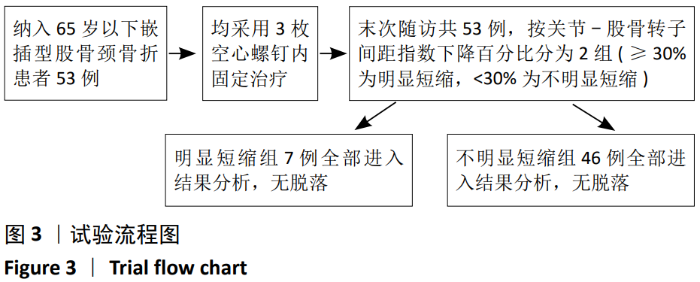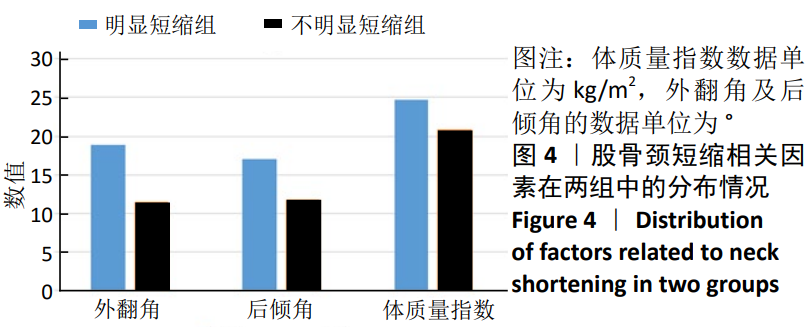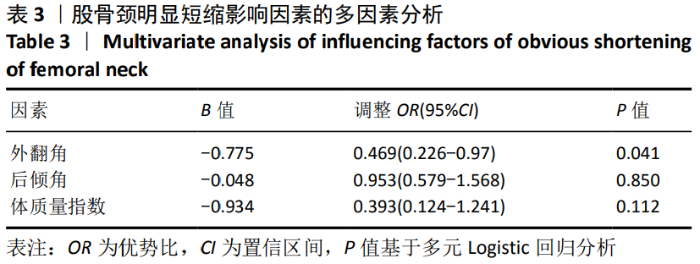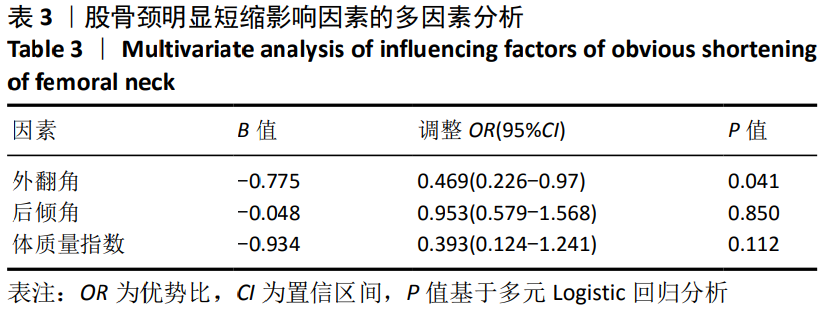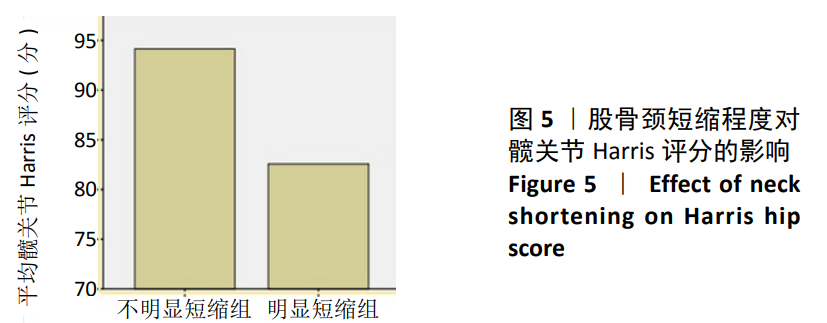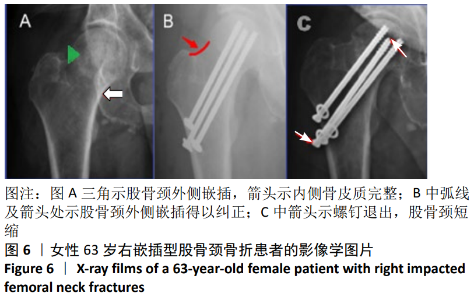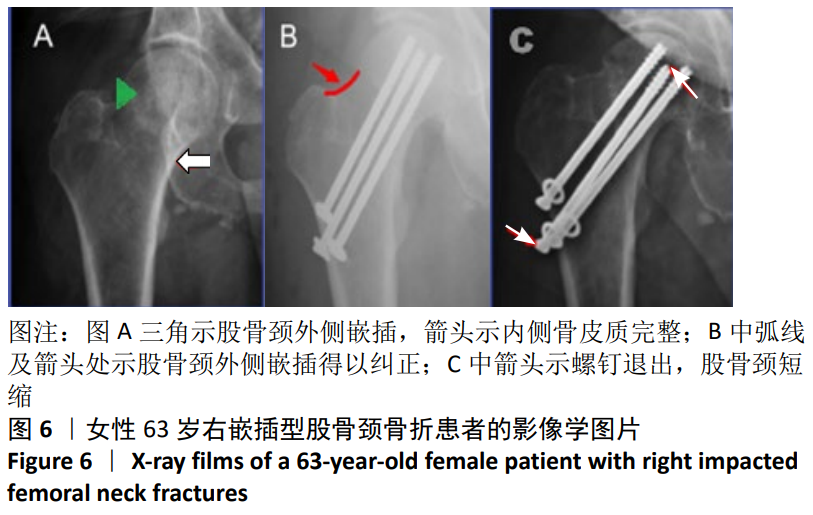Chinese Journal of Tissue Engineering Research ›› 2021, Vol. 25 ›› Issue (9): 1410-1416.doi: 10.3969/j.issn.2095-4344.3752
Previous Articles Next Articles
Effect of degree of initial deformity of impacted femoral neck fractures under 65 years of age on femoral neck shortening
Du Xiupeng, Yang Zhaohui
- Department of Orthopedics, the Second Hospital of Shanxi Medical University, Taiyuan 030001, Shanxi Province, China
-
Received:2020-04-03Revised:2020-04-10Accepted:2020-05-13Online:2021-03-28Published:2020-12-16 -
Contact:Yang Zhaohui, MD, Chief physician, Department of Orthopedics, the Second Hospital of Shanxi Medical University, Taiyuan 030001, Shanxi Province, China -
About author:Du Xiupeng, Master candidate, Physician, Department of Orthopedics, the Second Hospital of Shanxi Medical University, Taiyuan 030001, Shanxi Province, China
CLC Number:
Cite this article
Du Xiupeng, Yang Zhaohui. Effect of degree of initial deformity of impacted femoral neck fractures under 65 years of age on femoral neck shortening[J]. Chinese Journal of Tissue Engineering Research, 2021, 25(9): 1410-1416.
share this article
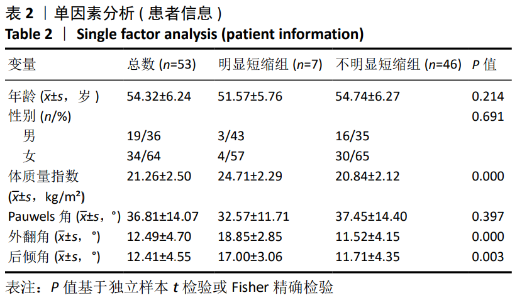
2.3 患者一般资料 53例患者均完成随访,随访12-24个月,末次随访全部骨愈合,无内固定失效及股骨头坏死等不良事件发生。 关节-股骨转子间距指数下降百分比≥30%表示明显短缩,<30%为不明显短缩,其中明显短缩组有7例(13%),不明显短缩组有46例(87%)。Pauwels分型中Ⅰ型12例,Ⅱ型35例,Ⅲ型6例。 2.4 股骨颈短缩相关因素分析 患者年龄(P=0.214)、性别(P=0.691)、Pauwels角大小(P=0.643)在两组中差异无显著性意义;体质量指数(P=0.001)、外翻角(P=0.000)、后倾角(P=0.001)在两组中差异有显著性意义,见表2及图4。将单因素分析结果中P < 0.05的影响因素进行多元Logistic回归分析,以明确明显短缩的影响因素。在Logistic回归模型的多元分析中发现外翻角是嵌插型股骨颈骨折颈短缩的显著预测因子(P=0.041)。外翻角调整后的优势比(OR)为0.469(95%CI:0.226-0.97),见表3。"
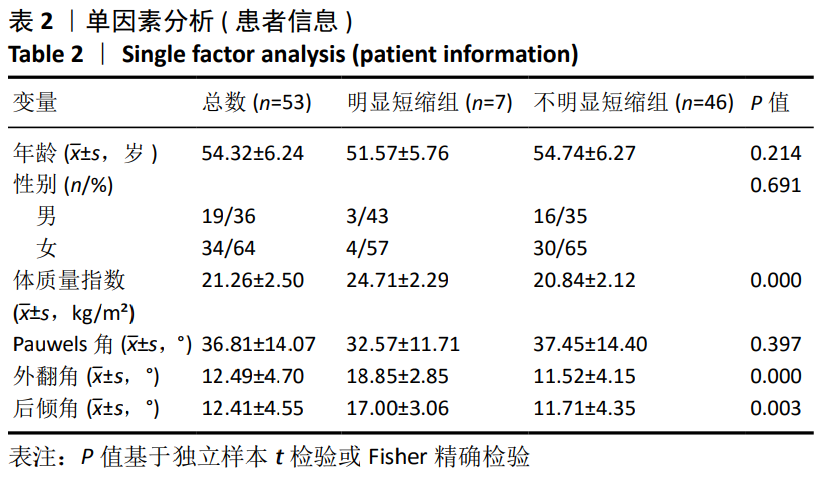
| [1] SONG HK, CHOI HJ, YANG KH. Risk factors of avascular necrosis of the femoral head and fixation failure in patients with valgus angulated femoral neck fractures over the age of 50 years. Injury. 2016;47(12): 2743-2748. [2] YOON PW, SHIN YH, YOO JJ, et al. Progression of a fracture site impaction as a prognostic indicator of impacted femoral neck fracture treated with multiple pinning. Clin Orthop Surg. 2012;4(1):66-71. [3] FLORSCHUTZ AV, LANGFORD JR, HAIDUKEWYCH GJ, et al. Femoral neck fractures: current management. J Orthop Trauma. 2015;29(3):121-129. [4] FELTON J,SLOBOGEAN GP,JACKSON SS, et al.Femoral Neck Shortening After Hip Fracture Fixation Is Associated With Inferior Hip Function: Results From the FAITH Trial.J Orthop Trauma. 2019;33(10):487-496. [5] SLOBOGEAN GP, SPRAGUE SA, SCOTT T, et al. Management of young femoral neck fractures: is there a consensus? Injury. 2015;46(3): 435-440. [6] ZLOWODZKI M, JÖNSSON A, PAULKE R, et al. Shortening after femoral neck fracture fixation:is there a solution? Clin Orthop Relat Res. 2007; 461:213-218. [7] AMSELLEM D, PARRATTE S, FLECHER X, et al. Non-operative treatment is a reliable option in over two thirds of patients with Garden I hip fractures. Rates and risk factors for failure in 298 patients. Orthop Traumatol Surg Res. 2019 ;105(5):985-990. [8] BUORD JM, FLECHER X, PARRATTE S, et al. Garden I femoral neck fractures in patients 65 years old and older: is conservative functional treatment a viable option? Orthop Traumatol Surg Res. 2010;96(3): 228-234. [9] TAHA ME, AUDIGÉ L, SIEGEL G, et al. Factors predicting secondary displacement after non-operative treatment of undisplaced femoral neck fractures. Arch Orthop Trauma Surg. 2015;135(2):243-249. [10] SLOBOGEAN GP, STOCKTON DJ, ZENG BF, et al. Femoral neck shortening in adult patients under the age of 55 years is associated with worse functional outcomes: Analysis of the prospective multi-center study of hip fracture outcomes in China (SHOC). Injury. 2017;48(8):1837-1842. [11] ZLOWODZKI M, AYENI O, PETRISOR BA, et al. Femoral neck shortening after fracture fixation with multiple cancellous screws: incidence and effect on function. J Trauma. 2008 ;64(1):163-169. [12] STOCKTON DJ, LEFAIVRE KA, DEAKIN DE, et al. Incidence,magnitude,and predictors of shortening in young femoral neck fractures. J Orthop Trauma. 2015;29(9):e293-298. [13] FELTON J, SLOBOGEAN GP, JACKSON SS, et al. Femoral Neck Shortening After Hip Fracture Fixation Is Associated With Inferior Hip Function: Results From the FAITH Trial. J Orthop Trauma. 2019;33(10):487-496. [14] SUNG YB, JUNG EY, KIM KI, et al. Risk factors for neck shortening in patients with valgus impacted femoral neck fractures treated with three parallel screws: is bone density an affecting factor? Hip Pelvis. 2017;29(4):277-285. [15] ZLOWODZKI M,BRINK O,SWITZER J, et al. The effect of shortening and varus collapse of the femoral neck on function after fixation of intracapsular fracture of the hip: a multi-centre cohort study. J Bone Joint Surg Br. 2008;90(11):1487-1494 . [16] RAGNARSSON JI,BOQUIST L,EKELUND L, et al. Instability and femoral head vitality in fractures of the femoral neck. Clin Orthop Relat Res. 1993;(287):30-40. [17] BORAIAH S,PAUL O,GARDNER MJ, et al.Outcomes of length-stable fixation of femoral neck fractures. Arch Orthop Trauma Surg. 2010; 130(12):1523-1531. [18] THOMAS H,JAKOB S,JULIAN H, et al. Femoral shortening does not impair functional outcome after internal fixation of femoral neck fractures in non-geriatric patients. Arch Orthop Trauma Surg. 2018; 138(11):1511-1517. [19] LIU Y, AI ZS, SHAO J, et al. Femoral neck shortening after internal fixation. Acta Orthop Traumatol Turc. 2013;47(6):400-404. [20] ZIELINSKI SM, KEIJSERS NL, PRAET SFE, et al. Femoral neck shortening after internal fixation of a femoral neck fracture. Orthopedics. 2013; 36(7):e849-e858. [21] THOMAS H,JAKOB S,JULIAN H, et al. Wozasek. Femoral shortening does not impair functional outcome after internal fixation of femoral neck fractures in non-geriatric patients. Arch Orthop Trauma Surg. 2018;138(11):1511-1517. [22] PARKER MJ, DYNAN Y. Is Pauwels classification still valid? Injury. 1998; 29:521-523 [23] CHIANG MH, WANG CL, FU SH, et al. Does fully-threaded Headless Compression Screw provide a length-stable fixation in undisplaced femoral neck fractures? Asian J Surg. 2019;42(1):320-325. [24] DELPHINE A,SÉBASTIEN P,XAVIER F,et al. Non-operative treatment is a reliable option in over two thirds of patients with Garden I hip fractures. Rates and risk factors for failure in 298 patients. Orthop Traumatol Surg Res. 2019;105(5):985-990. [25] SREEVATHSA B,OMESH P,MICHAEL J,et al. Retraction Note: Outcomes of length-stable fixation of femoral neck fractures. Arch Orthop Trauma Surg. 2012 ;132(5):739. [26] DE LAET C,KANIS JA,ODÉN A,et al. Body mass index as a predictor of fracture risk: a meta-analysis. Osteoporos Int. 2005;16(11):1330-1338. [27] CHEN X,ZHANG J,WANG X,et al. Incidence of and factors influencing femoral neck shortening in elderly patients after fracture fixation with multiple cancellous screws. Med Sci Monit. 2017;26;23:1456-1463. [28] KIM YC, LEE JY, SONG JH, et al. The Result of In Situ Pinning for Valgus Impacted Femoral Neck Fractures of Patients over 70 Years Old. Hip & pelvis. 2014;26(4):263-268. [29] SONG HK, LEE JJ, OH HC, et al. Clinical implication of subgrouping in valgus femoral neck fractures: comparison of 31-B1.1 with 31-B1.2 fractures using the OTA/AO classification. J Orthop Trauma. 2013; 27(12):677-682. [30] CROSBY JM, PARKER MJ. Femoral neck collapse after internal fixation of an intracapsular hip fracture: Does it indicate a poor outcome? Injury.2016;47(12):2760-2763. [31] RACZKOWSKI JW, DANISZEWSKA B, ZOLYNSKI K. Functional scoliosis caused by leg length discrepancy. Archives of medical science : AMS. 2010 ; 6(3):393-398. [32] MINKOWITZ RB,BHADSAVLE S,WALSH M ,et al. Removal of painful orthopaedic implants after fracture union. J Bone Joint Surg. 2007; 89(9):1906-1912. |
| [1] | Xu Feng, Kang Hui, Wei Tanjun, Xi Jintao. Biomechanical analysis of different fixation methods of pedicle screws for thoracolumbar fracture [J]. Chinese Journal of Tissue Engineering Research, 2021, 25(9): 1313-1317. |
| [2] | Jiang Yong, Luo Yi, Ding Yongli, Zhou Yong, Min Li, Tang Fan, Zhang Wenli, Duan Hong, Tu Chongqi. Von Mises stress on the influence of pelvic stability by precise sacral resection and clinical validation [J]. Chinese Journal of Tissue Engineering Research, 2021, 25(9): 1318-1323. |
| [3] | Zhang Tongtong, Wang Zhonghua, Wen Jie, Song Yuxin, Liu Lin. Application of three-dimensional printing model in surgical resection and reconstruction of cervical tumor [J]. Chinese Journal of Tissue Engineering Research, 2021, 25(9): 1335-1339. |
| [4] | Zhang Yu, Tian Shaoqi, Zeng Guobo, Hu Chuan. Risk factors for myocardial infarction following primary total joint arthroplasty [J]. Chinese Journal of Tissue Engineering Research, 2021, 25(9): 1340-1345. |
| [5] | Wei Wei, Li Jian, Huang Linhai, Lan Mindong, Lu Xianwei, Huang Shaodong. Factors affecting fall fear in the first movement of elderly patients after total knee or hip arthroplasty [J]. Chinese Journal of Tissue Engineering Research, 2021, 25(9): 1351-1355. |
| [6] | Wang Jinjun, Deng Zengfa, Liu Kang, He Zhiyong, Yu Xinping, Liang Jianji, Li Chen, Guo Zhouyang. Hemostatic effect and safety of intravenous drip of tranexamic acid combined with topical application of cocktail containing tranexamic acid in total knee arthroplasty [J]. Chinese Journal of Tissue Engineering Research, 2021, 25(9): 1356-1361. |
| [7] | Xiao Guoqing, Liu Xuanze, Yan Yuhao, Zhong Xihong. Influencing factors of knee flexion limitation after total knee arthroplasty with posterior stabilized prostheses [J]. Chinese Journal of Tissue Engineering Research, 2021, 25(9): 1362-1367. |
| [8] | Peng Zhihao, Feng Zongquan, Zou Yonggen, Niu Guoqing, Wu Feng. Relationship of lower limb force line and the progression of lateral compartment arthritis after unicompartmental knee arthroplasty with mobile bearing [J]. Chinese Journal of Tissue Engineering Research, 2021, 25(9): 1368-1374. |
| [9] | Huang Zexiao, Yang Mei, Lin Shiwei, He Heyu. Correlation between the level of serum n-3 polyunsaturated fatty acids and quadriceps weakness in the early stage after total knee arthroplasty [J]. Chinese Journal of Tissue Engineering Research, 2021, 25(9): 1375-1380. |
| [10] | Zhang Chong, Liu Zhiang, Yao Shuaihui, Gao Junsheng, Jiang Yan, Zhang Lu. Safety and effectiveness of topical application of tranexamic acid to reduce drainage of elderly femoral neck fractures after total hip arthroplasty [J]. Chinese Journal of Tissue Engineering Research, 2021, 25(9): 1381-1386. |
| [11] | Wang Haiying, Lü Bing, Li Hui, Wang Shunyi. Posterior lumbar interbody fusion for degenerative lumbar spondylolisthesis: prediction of functional prognosis of patients based on spinopelvic parameters [J]. Chinese Journal of Tissue Engineering Research, 2021, 25(9): 1393-1397. |
| [12] | Lü Zhen, Bai Jinzhu. A prospective study on the application of staged lumbar motion chain rehabilitation based on McKenzie’s technique after lumbar percutaneous transforaminal endoscopic discectomy [J]. Chinese Journal of Tissue Engineering Research, 2021, 25(9): 1398-1403. |
| [13] | Chen Xinmin, Li Wenbiao, Xiong Kaikai, Xiong Xiaoyan, Zheng Liqin, Li Musheng, Zheng Yongze, Lin Ziling. Type A3.3 femoral intertrochanteric fracture with augmented proximal femoral nail anti-rotation in the elderly: finite element analysis of the optimal amount of bone cement [J]. Chinese Journal of Tissue Engineering Research, 2021, 25(9): 1404-1409. |
| [14] | Zhang Shangpu, Ju Xiaodong, Song Hengyi, Dong Zhi, Wang Chen, Sun Guodong. Arthroscopic suture bridge technique with suture anchor in the treatment of acromioclavicular dislocation [J]. Chinese Journal of Tissue Engineering Research, 2021, 25(9): 1417-1422. |
| [15] | Liang Yan, Zhao Yongfei, Xu Shuai, Zhu Zhenqi, Wang Kaifeng, Liu Haiying, Mao Keya. Imaging evaluation of short-segment fixation and fusion for degenerative lumbar scoliosis assisted by highly selective nerve root block [J]. Chinese Journal of Tissue Engineering Research, 2021, 25(9): 1423-1427. |
| Viewed | ||||||
|
Full text |
|
|||||
|
Abstract |
|
|||||
